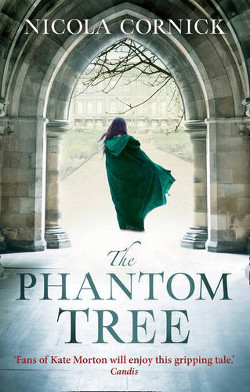 The Phantom Tree by Nicola Cornick is a historical mystery where the secrets of 16th-century England might unlock the answers to modern-day London mysteries.
The Phantom Tree by Nicola Cornick is a historical mystery where the secrets of 16th-century England might unlock the answers to modern-day London mysteries.
The crucial question in a time-slip story is who stays and who leaves the time period in which they were born. The Phantom Tree is a tale of two women: Mary Seymour, the “daughter of one queen and the niece of another,” and the enigmatic, modern-day Alison Bannister. Mary Seymour’s mother was Henry VIII’s last wife, Katherine Parr. Nicola Cornick deftly switches between the worlds of the Tudor-era Wolf Hall and Wiltshire and the London of today.
Alison is wandering through the “rain sodden streets of Marlborough,” eight weeks before Christmas. She’s hungry, wet, and not at all pleased to have landed in a “faux historical event”—a Victorian market in the town square manned by cheerful stallholders in appropriate costume.
Hate is not too strong a word for her feelings.
Beneath the crinolines and jackets they had on their thermal vests and long johns to guard against the cold. They had waterproof boots and raincoats. They thought this play-acting was fun, a jolly celebration of Christmas past. She remembered past Christmases very differently; the bone sharp cold, the damp, the chilblains and the hunger that had hollowed in her stomach. Even though she had been trapped in the present day for so long now that time had started to blur, some of her past she could remember with utter clarity. Pain, sickness, violence, death, had been a raw reality.
Who is this woman? Why does she feel trapped living in the present day since it doesn’t sound like the time she comes from was safe or comfortable?
Alison stops in front of a modern art gallery, her interest caught by a row of sixteenth-century portraits, specifically Henry VIII “painted at the moment his glorious, golden youthfulness was changing into something more watchful and inimical.” A portrait of a Tudor woman stops Alison cold.
It was a face she knew. Mary Seymour. Alison’s breath stopped. There was a tight pain in her chest and a buzzing in her ears. Mary. After all this time. She had never given up hope. It wasn’t in her nature to despair although she had come very close to it so many times. All the history books—those that mentioned Mary Seymour at all—said that she had died as a child. Alison had known that was not true but she had never discovered what had happened to Mary after she had left Wolf Hall. “Help me,” she had said to Mary all those years ago. “Help me to find my son. I’ll come back for him. Leave me word…” She had not begged, precisely; her relationship with Mary had been too prickly to allow her to show that vulnerability. She had phrased it as an order, but Mary had known. There had been a bargain between them.
When a character thinks “after all this time,” usually they’re not referring to 500 or 600 hundred years earlier. Clearly, however, Alison is. An elderly gentleman comes up to Alison while she is staring at the portrait and tells her that its subject is Anne Boleyn and that his godson—historian Adam Hewer—not only discovered the portrait, but also wrote a book about it: Discovering Anne Boleyn. He says proudly, “Apparently, there aren’t many portraits of Anne Boleyn.” To which Alison replies:
“And this isn’t one of them, I’m afraid,” Alison said. Rain was seeping down her neck, making her shiver. Or perhaps the shivers were coming from elsewhere, somewhere far deeper inside.
Alison knows Adam. A decade earlier they had a passionate, youthful affair. She broke it off abruptly, consumed with a need to return to the past and rescue her son. By this point, nothing surprises Alison.
Odd that it should be Adam, of all people, who should be the one to lead her to Mary. Or perhaps it was not odd at all. That sense of time shifting, the lure of the brightly lit window, the portrait… It had not happened by chance. When it came to fate and time she did not believe in coincidence.
Alison’s reaction of anguish and equanimity to Mary Seymour’s portrait is puzzling and mysterious. What happened between the two women centuries earlier? Through one woman’s journey, Cornick creates a mesmerizing world populated by the lost children of Wolf Hall.
To learn more or order a copy, visit:
Janet Webb aka @JanetETennessee moved from the San Francisco Bay to eastern Tennessee. Baseball is my passion: I follow the Chattanooga Lookouts and the Nashville Sounds (farm team of my beloved Oakland Athletics). Social media devotee. Stories on royals and politics catch my eye. Ottawa born. Grew up on the books of Helen MacInnes, Dick Francis, and Dorothy L. Sayers. I'm always looking for a great new mystery series. I also review at Heroes and Heartbreakers.
Read all of Janet Webb's articles for Criminal Element!

OMG! I love Nicola. She is a wonderful woman and a terrific writer. I haven’t heard from her in a while. Hmmm…..
Thanks for posting about this book!!
Ask most Americans – including most in Washington – what they think of Liz Truss and you will probably get a blank stare in return.